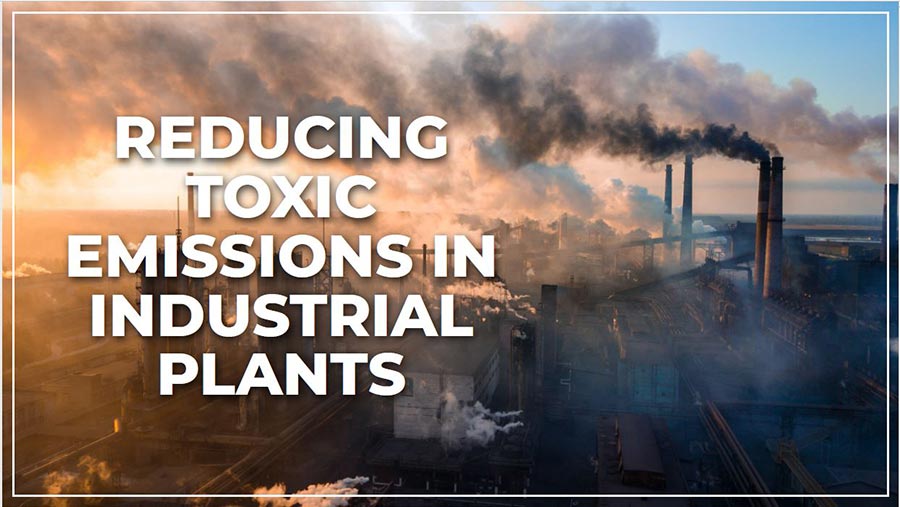Reducing toxic emissions: A holistic approach for industrial sustainability

Photo: Getty Images
Industrial plants — including manufacturing and power plants — are significant contributors to air pollution, emitting toxic substances that pose serious health risks to workers and the surrounding environment. While regulations exist to minimize these dangers, there are additional methods that can be incorporated to effectively reduce air pollution in these facilities.
Understanding the problem
Industrial plants are notorious for being among the largest sources of toxic emissions, releasing pollutants such as sulfur dioxide, nitrogen oxides, volatile organic compounds (VOCs) and particulate matter into the atmosphere. These emissions result from various industrial processes, including combustion, chemical reactions and material handling, and contribute significantly to air pollution and climate change.
Effective strategies to reduce air pollution
Switch to environmentally friendly equipment and materials: Transitioning to environmentally friendly equipment, technology and materials is a crucial step in reducing toxic emissions. For example, replacing traditional power cables with halogen-free bus ducts and bus plugs could help minimize electrical losses and decrease emissions associated with power distribution.
Utilize abatement technology: Implementing abatement technology — such as catalytic oxidizers, regenerative thermal oxidizers and wet scrubbers — can effectively destroy pollutants at their source of production. These systems utilize chemical processes to neutralize harmful emissions before they are released into the atmosphere, improving air quality and reducing health risks for workers.
Replace hazardous materials with greener alternatives: Substituting hazardous manufacturing materials with greener products and nonhazardous biocide alternatives can significantly reduce pollution and health risks for workers. By choosing eco-friendly alternatives, industrial plants could minimize their environmental footprint and promote sustainability.
Transition to cleaner energy sources: Shifting toward cleaner energy sources — such as wind, solar, biomass and geothermal systems — is essential for reducing toxic emissions. These renewable energy sources produce minimal air pollution and greenhouse gas emissions, offering a sustainable alternative to fossil fuels.
Utilize natural gas: Switching to natural gas as an energy source can help reduce emissions and mitigate the environmental impact of industrial operations. While not perfect, natural gas is considered cleaner than traditional fossil fuels, with lower levels of sulfur and mercury pollution.
Balance supply and demand: Implementing strategies to balance supply and demand within industrial processes can lead to decreased levels of VOCs and other air pollutants. By optimizing production processes and minimizing waste generation, industrial plants could reduce their overall environmental impact and improve air quality.
Utilizing cooling tower suppliers to enhance efficiency and sustainability
Cooling towers play a crucial role in industrial plants, helping to dissipate heat generated during various processes and maintain optimal operating temperatures. Partnering with a reputable cooling tower supplier offers numerous benefits for these facilities, such as:
Expertise and guidance: Suppliers offer specialized knowledge, assisting plants in selecting tailored cooling tower solutions and providing comprehensive support from design to maintenance services, including routine inspections, repairs and upgrades.
Customized solutions: Suppliers design solutions to maximize efficiency and minimize energy consumption, analyzing factors such as plant layout and cooling requirements.
Advanced technologies: Leveraging cutting-edge innovations, suppliers enhance cooling systems' efficiency and sustainability, reducing water consumption and environmental impact.
Energy savings: Upgrading to energy-efficient systems through suppliers can yield significant cost reductions, lowering electricity consumption and operational expenses.
Environmental compliance: Suppliers aid in meeting regulations and sustainability goals by offering solutions that minimize water and chemical usage, thus reducing emissions and environmental footprint.
Reducing toxic emissions is essential for protecting human health and preserving the environment. By implementing a combination of these strategies, industrial facilities can take the next step in significantly reducing their environmental footprint and contributing to a healthier, more sustainable future.
Would you like to learn more about reducing air pollution in the industrial sector? Please see the accompanying resource for further information.
Resources
Reducing Toxic Emissions in Industrial Plants (PDF)
https://www.thecmmgroup.com/reduce-air-pollution-factories-industrial-operations/
https://www.c2es.org/content/regulating-industrial-sector-carbon-emissions/
Looking for a reprint of this article?
From high-res PDFs to custom plaques, order your copy today!









